| |
We Command the Sun, the Earth and the
Winds
In mid summer 1945, two generals walked through American run
Bad Kissingen following a private lunch. Military police,
staff officers and aids keep a respectful distance as the
pair briefly enjoyed the promenade along the Saale River,
down the former Adolf Hitler Strasse, newly re - named as
Roosevelt Strasse and past the elegant Kur Hotels occupied
by the victorious Americans. This was not just another shot
out Kraut town - everything was frozen in time, intact -
little hint of the war beyond the one blown bridge.
Rain the previous night, but the sky had cleared and there
was a distant but growing rumble coursing through the
valley; storms again? The pair reached the reviewing stand
in the park area, climbed to the podium and brief remarks
were made to hundreds of assembled Army Air Corps personnel.
They were in loose formation and there were no invited
German guests. This was victory and this was a part of the
American celebration.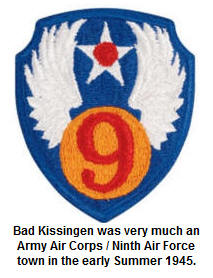
Binoculars were handed to the generals; one turned to the
other and made a sweeping gesture with his arm across the
blue sky as the rumble grew louder. Both men put in cotton
ear plugs, the noise was now so loud that normal speech was
almost impossible. First through parting clouds, a single
P51 fighter, following the river from the south. It cork
screwed a barrel roll maneuver just hundreds of feet above
the crowd and its shadow flashed, specter like across the
streets, along the walls and over red tiled roofs of the
town. The growing roar of approaching aircraft engines was
now deafening, the leafs trembled, the enormous sound
reverberated through the bodies of the assembled men, the
sky was clear and then the town sank into shadow, the sun
was blocked out.
Look to the Sky, We Darken the Sun!
Here are four brief New York Times articles and then the
associated stories that help illustrate the American
experience in Bad Kissingen during the first days of peace
in Germany. While most of us recall the town as an Army
garrison of cavalry and artillery units, in the immediate
post war period, the full power of the American Army Air
Corps was everywhere, they could darken the sun, they could
cover the ground and even predict the weather.
( I ) 40 Mile Air Parade to Mark Anniversary - New York
Times - July 30 1945
London, July 29 - an aerial parade forty miles long will fly
over the major European cities on Wednesday to mark the
United States Army Air Forces thirty - eighth anniversary.
Aerial exhibitions will be held over Britain, France,
Belgium, the Netherlands and Germany, with a special review
over Bad Kissingen, the German headquarters of the Ninth Air
Force, to be reviewed by Major General O. P. Weyland.
Approximately 900 planes will participate in the aerial
demonstration including 600 Ninth Air Force Thunderbolts and
Mustangs and Marauders of the Ninth, Twelfth and Twenty -
Ninth Tactical Air Commands. The planes will fly low over a
number of former air targets and other places in Germany.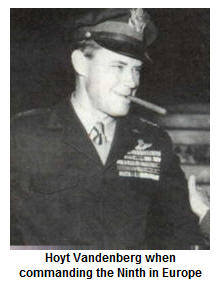
The article concluded by recalling the plans for an air
power parade and exposition in Paris that same week.
>>>
As reported in the Times, the guest of honor at Bad
Kissingen, at what must have been a overwhelming and
frightening display of American air power, was Army Air
Corps Major General Otto Paul Wayland. He was being honored
by his former boss, the soon to depart commander of the
Ninth US Air Force, Lieutenant General Hoyt S. Vandenberg.
Both men were visionaries who made remarkable contributions
to the Army Air Corps, the victory in Europe and formation
of the early American Air Force. At Bad Kissingen, they met
to say farewell, toast their victory, celebrate American air
power and enjoy the show.
O. P. Wayland had an interesting career in pre war Army
aviation that featured varied flying and staff assignments.
Because of the comparatively small pool of aviation
officers, promotions were slow. Once the US entered World
War II, however, his career path suddenly blossomed and he
quickly rose to Brigadier General in command of a fighter
wing. In 1944, he took command of the XIX Tactical Air
Command in England, consisting of two fighter groups, the
100th and the 303rd with the primary mission of escorting
heavy bomber groups in raids over Germany and France.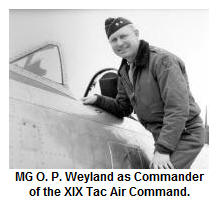
While flying from England, the XIX began to receive new,
light and medium bombers as well as specially developed
fighter - bomber aircraft. The command was directed to
explore what was necessary, both in terms of training and
equipment, to more closely integrate aircraft support to
combat operations of ground units in the planned invasion.
Tentative plans were made and in mid 1944, with the invasion
of France, the XIX TAC was tasked with the direct tactical
air support of General Patton’s Third Army. To accomplish
this, Weyland now had 25 separate squadrons of fighter,
light bomber and reconnaissance aircraft supported by
battalions of ground personnel building airfields, repairing
aircraft and integrated into forward units as controllers.
The mission and tactics of the XIX Tac Air evolved once the
battle was joined in France. While air supremacy was still a
major concern, the grand experiment of close tactical air
missions flown in direct support of forward ground echelons
began in earnest. What had been discussed and experimented
on in England, became a standing mission for the command,
although surprisingly, the idea of close air support was not
immediately embraced by all senior air or ground officers.

The idea of using aircraft to attack targets that earlier
doctrine said should be engaged with field artillery took
some getting used to by commanders throughout the Army.
Wayland and the general officers who supported the doctrine,
knew that the most effective sales pitch was success and
when the break - out from Normandy was spearheaded with
close air support, detractors were silenced once and for
all. It was said that Wayland’s planes could “ be called in
a minute and then turn on a dime “.
In reality, it would not be until Korea that fighter -
bomber missions would actually have the capability to loiter
in an area waiting for a mission from ground controllers but
the XIX Tac Air, and its Army Air Corps companion units, IX
Tac Air and XII Tac Air supporting the balance of US forces
in the France - Belgium - Germany campaign, did much to
explore and advance the doctrine of close air support.
Success was a matter of intelligence, intense planning,
innovation and very close coordination with the ground
forces extending down to regimental and battalion
commanders. It took a while for the radios, doctrine and
training to catch up with what Wayland and his staff
realized could be a possibility.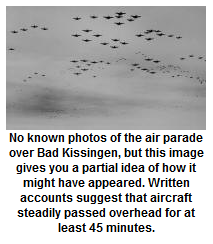
To support the emerging close air support doctrine, American
industry produced vast fleets of aircraft designed
specifically for precision bombing at low altitudes.
Specialized medium bombers, the B 26 Marauder, a good
example, modified fighters, P 51 D Mustang and the ultimate
World War II US fighter - bomber, the P 47 Thunderbolt were
rolled out in fast fashion to meet what commanders demanded
. As new aircraft were approved for production and
deployment, pilot training at dozens of stateside bases
specialized in the specific skills of close tactical air
support flying. What they did not learn in Texas or
Tennessee, was quickly picked up in the field. It was,
nevertheless, dangerous flying, attacking at low speed,
often against well defended targets in almost all types of
weather. Causality rates among crews were high.
Of almost equal importance to the aircraft and trained
flyers was the need to have Army Air Force radio teams with
the lead echelons of combat forces who were thoroughly
familiar with aircraft capabilities, the language of pilots
and the ground commander’s plan of attack. O. P. Weyland
helped design and test what would become ground based
forward air controllers as well as the mobile staffs that
approved, routed and, on occasion, redirected the attacking
flights. Often times message traffic for critical missions
still had to pass through various levels of headquarters for
approval but the radios, dedicated telephone networks and
trained staffs made the system surprisingly responsive in
terms of World War II expectations. From the fight across
France to the Battle of the Bulge to the final victory in
Germany, division and corps commanders from General Patton
down consistently singled out Wayland, his aircrews and
staffs for specific praise.
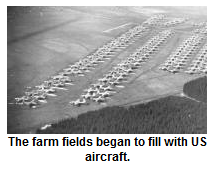
That mid summer day in Bad Kissingen, Major General Wayland
was the guest of Lieutenant General Hoyt S. Vandenberg,
commander of the Ninth US Air Force with his headquarters at
the Kurstadt. This was the link that brought the air parade
seen over London, Paris and Berlin and a dozen now bombed
out cities in Germany to the otherwise sleepy town on the
Saale. With the war over, Wayland was to return to Fort
Leavenworth as the new Assistant Commandant of all Army
schools there. Vandenburg was slated for the position of
Assistant Chief of Staff of the Army Air Force in Washington
and he took the opportunity to honor his old friend and
former subordinate. At the air parade, both generals would,
at least symbolically, say farewell to their combat
commands. From the reviewing stand, eighteen months of
intense work flashed overhead in a terrible parade.
Less than a month later, Vandenberg relinquished command to
Major General Bill E. Kepner, former commander of the Eighth
Air Force in Germany. With the war over and Army of
Occupation plans moving forward, the only major Army Air
Force command slated to remain in Germany was the Ninth and
in many ways, it was being dramatically reconfigured for a
new mission. While some air assets would remain, the men of
the Ninth were to become part of the force policing post war
Germany and of particular note, they were tasked with the
search for secret Luftwaffe technology.
In later years, O. P. Wayland’s career continued with a
variety of significant staff and command positions to
include overall command of Tactical Air Operations in
support of US forces in the Korean war. He was responsible
for the building of the modern Japanese Air Force in the mid
1950s and received his fourth star. Weyland retired from
active duty in 1959 and died in 1979. He is acknowledged as
one of the founding fathers of American modern tactical air
support.
Hoyt Vandenberg left Germany and returned to Washington. In
rapid succession, he was assigned as the director of the
newly formed Central Intelligence Agency, the Vice Chief of
Staff and then Chief of Staff of the new, separate Air
Force. He died in 1953 after cancer forced a premature
retirement, however his name is forever recalled with the
military space and defense program located at Vandenberg Air
Force Base Rocket Missile Launch Facility in southern costal
California.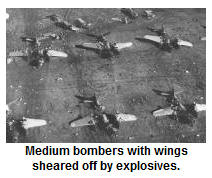
In Bad Kissingen, there are no official recollections of
this spectacular air parade although the memory of a sky
darkened by hundreds of low flying aircraft and the
accompanying engine roar must have lived on for some time.
The Saale Zeitung and other local newspapers were out of
print and would not resume publication until the late 1940s;
reporters may have made notes but there was nowhere to
deliver the story. With day to day needs of food and shelter
very much concerns even in the Rhoen, apparently even the
ever present German amateur photographers did not reach for
their Leicas. Likewise, official Army Air Corp photographers
also seem to have missed the event as there were no
surviving photos from the day. The shadows of hundreds of
over head aircraft soon left Bad Kissingen but interesting
shadows gathered for many months on near by valley floors
throughout Bavaria.
Look to the Valley, We Cover the Ground!
(II) Big Plane Reserve Rests in Germany - New York Times - 7
August 1945
Munich, Germany, 6 August - Kathleen McLaughlin -
Hundreds of Fortresses to Be Joined by Other Bombers, Many
Fighter Aircraft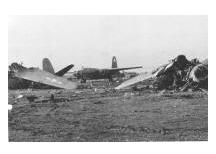
Aligned wingtip to wingtip and nose to tail in precise
geometrical formations, a sea of B 17s unfold in an
impressive panorama around a bend in the highway that
stretches from Munich to Salzburg.
Hundreds of Flying Fortresses are concentrated on this
former Luftwaffe center and another 100 arrived yesterday.
More are to arrive within the next few weeks.
This is the largest reserve pool of heavy bombers in United
States occupied territory and it is an object lesson that
needs no interpretation to the tens of thousand of Germans
who pass here daily.
The lengthy article went on to explain that many of these
aircraft were delivered directly from other holding areas
and had in fact, never participated in actual combat, they
were reserve aircraft. Once that group was pooled, then the
combat aircraft units would likewise add their aircraft to
this area and others fields and lots nearby. A small group
of Army personnel were responsible for guarding the assembly
areas and the fate of the air armada was currently under
review. There was some speculation that the area would
become a training center for future pilots and crews.
>>
The victory air parades held by the Americans in the Summer
of 1945 had a secondary function beyond impressing war weary
Germans and saluting departing general officers. The parades
were used to help funnel US aircraft to central locations in
southern Germany for final disposition. Within days of the
end of the war in Germany, the War Department cancelled
thousands of defense contacts across the United States,
staffs worked over time to identify which troops were needed
in the Pacific, who might be released from active duty and
what to do with all that equipment that had just won the war
against the Fascists.
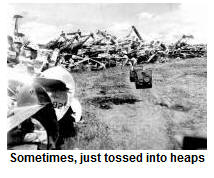
Manufactures who had been staffing factories at three full
shifts building aircraft for use in Europe were, upon
receipt of a single telegraph message, ordered to
immediately cease production and plan for a rapid return to
consumer oriented products. While the war against Japan was
yet to be decided, Washington had no further need for B17s,
P47s or dozens of other aircraft seen as not suitable for
the Pacific theater. Production lines stopped all over
America with a frightening efficiency. One shift left the
plant - no further shifts were called. In the Army Air
Corps, crews and support personnel not needed elsewhere,
were discharged as soon as possible; all of the aircraft
posed a particular problem.
The fate of thousands of aircraft that carried the best
American technology available at the time into European
skies is indicative of just how dramatic the shift to a
peacetime economy was planned to be. The same planes that
saluted dignitaries at a few select European locations in
the air parades, once landed, were pooled at huge collection
points in the American occupied zone in deep southern
Germany by men who reported to BG Frank Camm and his Office
of Liquidation, part of the War Assets Administration. Camm
would be the cutter and crusher.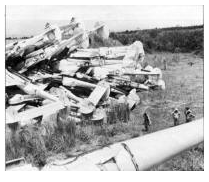
Camouflaged or silvered wings gleaming in the late Summer
sun, they were parked wing tip to wing tip until heavy and
medium bombers, fighters of every type plus light aircraft
and transports paved entire valley floors in Bavaria
stretching to Austria as far as one could see. At the
beginning of the collection program, the Army considered “
moth balling “ the fleet for storage but under review, this
was deemed impractical - south German weather is not
friendly to outside warehousing plus, clear eyed planners
noted that the prop driven aircraft that won a European war
in 1945 were probably not in their thinking with the dawn of
the jet age. That left only one real alternative.
In most cases, the engines were first stripped out first, to
recycle the high grade steel and aluminum. The remaining
airframes were then torn apart, blown up, run over by bull
dozers or burnt in massive fire pits. What was left was
scooped up and sent to the regional smelters. A few months
later, similar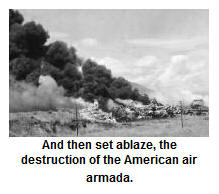 bonfires burned across the Pacific consuming
a second American air war fleet. bonfires burned across the Pacific consuming
a second American air war fleet.
Local Germans observing these activities in the late Summer
of 1945 must have looked on with a sense of disbelief mixed
with war weary irony. First, the Americans had driven the
Luftwaffe from the sky and bombed Germany virtually at will
for months on end. Then, peace came yet they filled the
skies one last time with aircraft. Flying in massed
formations at low altitude, the sound was as though a
thousand locomotives were screaming past. A few allied
generals and politicians looked up and smiled; at least this
time, the Americans dropped no bombs. Finally, the
conquerors clogged roads, fields and valleys with miles and
miles of parked aircraft until the countryside could hold no
more and then … they burned their planes.
Hitler and Goering had promised that Germany would witness
the destruction of the attacking American air armada. For
southern Bavarians looking on from hill top wood lines in
September and October 1945, this prediction had very much
come to pass.
Look to your fields, We Predict the Weather!
(III) U.S. Weatherman to Aid Reich - New York Times - 26
July 1945 -
Drew Middleton
Bad Kissingen - Germany - 25 July - Reuters
One of the first moves to help Germany feed herself has been
taken by the Ninth Army Air Force, which is making its
continental weather service available to German farmers, it
was revealed today.
The Germans own service collapsed with the defeat of the
Reich, and this new measure will enable them to get long
range forecasts to assist their crop planting.
>>
In immediate post war Germany, for local agriculture to
resume feeding the German population, a lot of things needed
to go right. A fast release of POWs was necessary to work
the fields, seed and brood stock were required to jump start
production; the harvest of 1945 was a disaster and the
Allies were squabbling over who owned what, the amount of
war reparations to be paid and where the meager harvest
might go. It seemed as though the Winter of 1945 would be
one of politics and privation.

What to do about starving Germans was a vexing question in
Washington. Some argued that whether 10,000 starved or
100,000, it made little difference, they were all Nazis or
supporters and a harsh peace was the dividend of the war
they waged. On the other hand, the occupying forces saw
nothing but trouble. Lack of food led to an explosion of
black market activity and general lawlessness. In the French
and British zones, already feeding programs were underway
and in America, even though the horrors of the holocaust
were being publicized, there was no wide spread demand for
revenge once the European war was finished.
After some political debate, it was determined that the
American zone of occupation would not become a zone of
starvation, food supplies would be made available in true
emergency situations and a major effort was announced to
reestablish German agriculture by the Spring of 1946.
Of all aspects of German society that Americans explored and
assisted in during the immediate post war period, one of the
more important efforts yet seldom recalled activity was the
resurrection of the German Weather Service. It needed to be
rebuilt and from the Summer of 1945 thru 1947, the center
for these efforts was Bad Kissingen. In Washington, where
some senior officials said, “ let them starve “ … in
Germany, the Army Air Corps said, “ let’s reconstitute the
Weather Service so that the farmers can resume work . “
(IV) Germans in Weather Unit - New York Times - 11 January
1947
450 Now Employed in Stations U. S. Official Reports

Berlin - Col. Don McNeal, head of the United States
meteorology section here, reported today that German
meteorological services in the United States zone now
operated two forecasting centers, five secondary forecasting
centers, thirty - five synoptic observing stations, eight
mountain observing stations, fifty - five climatological
stations of higher order and 1056 rain and snow stations.
The organization, with headquarters in Bad Kissingen, has
450 full time German employees supervised by United States
officers. It has been built up in accordance with an Allied
Control Council agreement to set up zonal meteorological
agencies which later will be merged into one national
governmental service.
>>>
In the pre war years, Germany had a highly sophisticated
National Weather Service and with a central location in
Europe, it played a key role in collecting, processing and
passing on vital weather data to bordering countries. With
the coming of the Nazi state, much of this operation was
brought into the military with data collection and analysis
preformed by the Luftwaffe, Navy and the Army. From Berlin,
the information necessary for civilian activities, from the
weekend weather report to detailed farm related projections,
was then parceled out by appropriate government ministries.
Only the archives of the old weather service and certain
laboratory functions remained in civil hands. Some private
metrological research and data collection was performed at
schools and universities across the country and then shared
through academic circles.
Much of this was undone with the loss of the war.
Weather stations, records and equipment were lost or
damaged, trained observers, technicians and weather
scientists had been drafted, served on all fronts, and their
ranks were thinned by the war. In mid Summer 1945,
Eisenhower declared that efforts needed to be made to locate
as many trained German metrological personnel as possible in
the Allied PW camps. If there was to be a Fall planting in
1945, the crops needed to go in fast with agriculture
supported by accurate weather data. In the interim period,
the Army Air Corps would provide observations and
predications within its capability but a new German Weather
Service needed to be reconstituted.
In Berlin, the man tasked with the job in the American zone
was Army Air Corps Colonel Don McNeal working with the US
5th Weather Group. He had distinguished himself during the
war by creating the schools necessary to find and train
thousands of servicemen who would become the weather
observers, analysts and technicians supporting the global
American war effort. He was a 1934 graduate of Cornell with
a masters degree in geo and planetary sciences from Cal
Tech; he was the Army’s weatherman.
Under McNeal’s command were a pair of names that would
appear prominently in Air Force weather circles well into
the 1990s, Lt. Paul J Bodenhofer and CPT Richard M. Gill as
well as two German scientists, the Weickmann brothers,
Helmet and Karl. Gill had a particularly interesting task in
the immediate post war period. With a team of Signal Corps
personnel, he dashed across what would become the Soviet
zone in Germany looking for German weather stations and
stripping them of key instruments that were packed and
rushed back to the American zone. Bodenhofer, after
graduation from UCLA in 1938 with a degree in geo science
and atmospheric studies, had done graduate work in Germany
prior to the war and had met many of the top German weather
scientists of the day. His knowledge of both the language
and the personalities proved key in the early days of
reorganizing the weather service.
Helmet and Karl Weickmann were geo science university
professors who had spent the war in Germany and for the most
part, were not associated with the Nazi period of the German
Weather Service. They were on the “ Paper Clip “ list of key
scientists the Americans were rounding up and shipping back
to the United States but for about four months at the end of
1945 and into 1946, they were prominent in putting a “
German face “ on the rebuilding effort.
From the first stages of the project, McNeal knew he was
rebuilding an organization that should become a German
responsibility as soon as possible. His orders required
intense cooperation with the British and French zones of
occupation, represented respectively by a Captain Darking
and Lt Valade and technically, with the Soviet zone as well.
His counterpart there was Major Trupikow. An indicator of
things to come, coordination went fairly smoothly in the
West, it was another matter with the Russians.
Among demands from the Trupikow was that the new service
headquarters be located in Berlin, a reasonable request in
1945, that it be in the Soviet portion of the divided city
and ultimately, come fully under Russian jurisdiction -
these latter demands were totally unacceptable to McNeal and
his bosses.
The Americans at the Office of Military Government in Berlin
proposed that as the framework for the new German Weather
Service, seven regional data collection and analysis hubs
would be established. The English and French zones each
would have one major weather center and a corresponding
reporting network. The large Soviet zone likewise received
only one center, in Dresden. Four weather reporting centers
were to be in the American zone to include one in Bad
Kissingen.
As a compromise on the Berlin question, the Americans
proposed a significant German weather laboratory would be
established at Templehof airport in Berlin located in the
American zone of the divided city. The final location of the
new weather service headquarters was not specified but at
the time, the Americans did not foresee a permanently
divided Germany so Berlin was not officially ruled out. A
specified goal of the Allies was that as soon as practical,
the rebuilt German Weather Service hubs under the
supervision of the French, English and Russians, would be
merged with the American effort to create one of the very
first large post war German national bureaucratic
organizations. This was to be one, small but important early
step to a rebuilt German nation.
A Ninth Air Force Lieutenant named Peters was the chief of
the Bad Kissingen weather office. He was soon joined by a
former senior Luftwaffe weather specialist, Kurt Burger,
plucked from one of the camps along with a cadre of other
former PWs to work with Ninth Air Force counterparts. As
more local Germans with weather analysis experience were
found or trained, gradually the observation and analysis
network spread from the hub across the countryside.
Because the Americans were taking overall responsibility for
reestablishing the service and personnel from the Ninth Air
Force were very much involved, by the Fall of 1945,
Kissingen was named as the defacto headquarters for all
weather data collection in the American zone.
Just how much data came in from the British and French zones
is not clear, but these allies were eager to hand off many
post war requirements in their sectors to the Americans, if
for no other reason than to cut administrative costs and
responsibilities. It seems safe to conclude that in both
North Germany, the British zone, and the French occupied
Eiffel region of far western Germany, the reestablishment of
the hub and observer system using German personnel as much
as possible, followed the familiar American pattern.
In one of the many ways that early fracture lines of the
Cold War were slowly becoming evident, the weather data in
the Russian occupied zone was reported to Dresden and only
occasionally and in summary fashion, did Dresden bother to
report to Kissingen.
As more weather and climate trained German technicians were
located, the American presence in the weather service
steadily diminished with many of the Army Air Corps
personnel in Germany being released from active duty or
transferred to the 8th Weather Group being built up in the
Arctic. Records report that as early as the Fall of 1945,
Peters already had a staff of twenty experienced Germans
including several staff members with university level
training.
By the middle of 1946, with the exception of senior staff
members at Kissingen, an all German weather service had been
largely rebuilt in the American zone, with its offices on
several floors of a local Kurhotel pressed into service as
office space. The following year, the weather reporting hubs
and networks under English and French control were fully
integrated into the American zone network and US supervision
of day to day activities of the German weather service began
to close down.
In the Eastern Zone, the Russians had built their own
weather observation and analysis network, declared Dresden
the headquarters with little interest in sharing information
or further integration into a larger network. Even the very
air and clouds had taken on a decidedly East and West German
nature.
By 1954, the Central Office of the German Weather Service
was free of American supervision and relocated from Bad
Kissingen to Frankfurt once a sufficient headquarters was
built. Two years later, as the Federal Republic of Germany
came into being as a sovereign nation, the Central Office
relocated again to their current home in Offenbach.
During the 1950s and 1960s, coordination between the East
German Weather Service and its West German counterpart
increased in the interest of overall German safety. With the
reunification of the two Germanys in 1991, the Dresden hub
and its full network of reporting and observing stations was
finally fully integrated into the modern unified German
Weather Service..
>>
Returning to Bad Kissingen and the days of Daley Barracks in
the early 1980s, although the West German weathermen had
long left the town, Cold War politics was still very much in
the air and on the shelf.
Prominently displayed in the Eaglehorse Squadron S2 office
was a pile of black plastic and aluminum bits and pieces in
a partially crushed cardboard box. These were the remains of
a Radiosonde, an East German weather observation instrument
that once had been carried aloft by helium balloon, then
drifted into squadron border area and crashed hard by a
road.
As I recall the story, these semi disposable devices were
launched by the weather services of almost all nations to
take simple measurements at altitudes in excess of 100,000
feet. What goes up, sooner or later, comes down and one or
two East German models per year were found by cavalry
troopers. By agreement, whatever was plucked from a tree or
found in a field was to be turned over to the BGS for formal
repatriation to the East, however, this one seemed to never
quite leave the office.
We used to joke that it was the perfect Trojan horse,
silently listening to all of our conversations and then
reporting back to Meiningen each night: the level of
pressure in the cavalry headquarters was high with extreme
amounts of hot air present in the conference room and that
regardless of the season, it was currently snowing at
Wildflecken.
September 2012
|
|